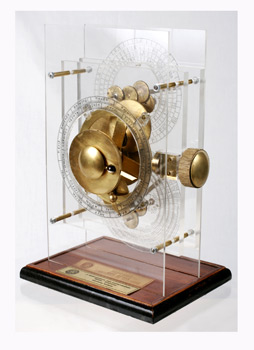
The Antikythera mechanism is an ancient mechanical device and it was discovered in the Antikythera wreck off the Greek island of Antikythera, along with many other antiquities by sponge fishermen in 1901. It contains over 30 gears, and is sometimes called the first known analog computer.
It appears to be constructed upon theories of astronomy and mathematics developed by Greeks and it is estimated that it was made around 80 BC. All the instructions of the mechanism are written in Greek.
The device is remarkable for the level of miniaturization and for its complexity.
It has over 30 gears, with teeth formed through triangles. When a date was entered via a crank (now lost), the mechanism can give a simulation of the relative position of the Sun, Moon, or the 5 planets known to ancient Greeks in relation to time. The mechanism was based on the geocentric model, it has three main dials, one on the front, and two on the back. The front dial has two concentric scales one shows the 365-day Egyptian calendar. Inside this, the a second dial shows the Zodiac. The upper back dial is a spiral, with 47 divisions per turn, displaying the 235 synodic months of the 19 year Metonic cycle. The lower back dial is also in the form of a spiral, shows the Saros cycle. A small lower back dial gives all the important athletic events in ancient Greece.
The original device is displayed in the Bronze Collection of the National Archaeological Museum of Athens. The most recent findings of The Antikythera Mechanism Research suggest that the mechanism was made by Corinthians and it may have a connection with the theory of Archimedes.
For more information see also the Journal of the Royal Astronomical Society of Canada, 101 (3), 93 – 94 (2007) and the article “Decoding the Antikythera Mechanism”, Nature, Volume 444, Issue 7119, pp. 587-591 (2006).


